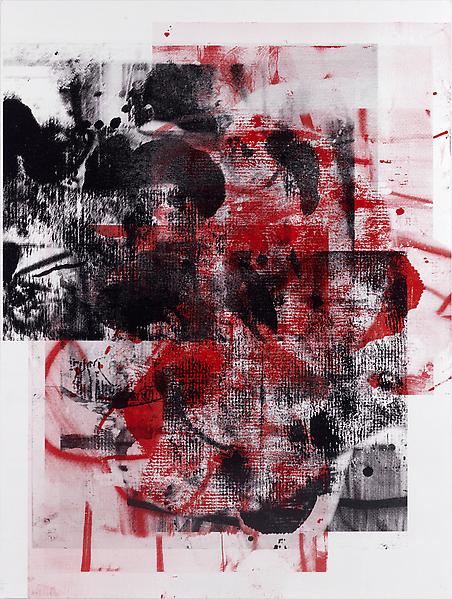Investigating combining lino print with etching so the image plus its "ghost" and "negative" appear on the same sheet. For example, the black double loops at the left side are ghosted in the etching, top right of the image.
The technique for this involved printing the lino onto tissue in the wood press, then offsetting that print onto dampened Somerset paper, in the etching press. Leaving the paper caught between the rollers, a further two etching plates were printed one after the other, to get a combined offset lino with two plate coloured etching.
The lino part of the image bleeds off the two edges of the paper (although here appears more faded than it is), whilst the etching part is more conventionally positioned within a white border or "window".
I came across this Christopher Wool's print after I had done my prints shown above. I could add more lino images to my etchings. However, before I saw Wool's print, I had already decided to remove the square edges of the lino image, to remove the "window" from that part.
 |
| Christopher Wool, Untitled, Silkscreen 2009
www.luhringaustine.com
|
 |
| choosing the piece of lino image |
Choosing the piece of lino image - sitting on the cutting board - in itself an image I could explore....
Printing the lino, cutting the tissue, offsetting, double etch coloured print.....each print took a staggering two hours to print! A lengthy process!
These prints contrast the lino image bled from the paper edge with the etching image more constrained in the picture window, hopefully setting up a tension. The contrasting colour of the lino image works best but needs to be printed over the etchings to stand out more. (Not sure what will happen to it printed over plate embossing, which at the moment I've managed to avoid).
All these prints obviously look different (and hopefully better) when viewed in the flesh rather than by camera phone. You can see the subtleties of layering of shapes and colours, which don't come out so well on photographs.
So, further work on these plates would be:
1. small section of lino printed last over etched plates
2. more lino images printed on etchings, looking at Wool's prints, either as the whole square lino plate or as sections.
And after that.....where next? Pushing the random marks further? Using photographic images and seeing what acid does to them? Bringing back a theme together with process? (Architecture would be good...linking my profession).
Printing the lino, cutting the tissue, offsetting, double etch coloured print.....each print took a staggering two hours to print! A lengthy process!
 |
| Blue/black offset lino on two plate etching |
 |
| Red offset lino on two plate etching |
All these prints obviously look different (and hopefully better) when viewed in the flesh rather than by camera phone. You can see the subtleties of layering of shapes and colours, which don't come out so well on photographs.
So, further work on these plates would be:
1. small section of lino printed last over etched plates
2. more lino images printed on etchings, looking at Wool's prints, either as the whole square lino plate or as sections.
And after that.....where next? Pushing the random marks further? Using photographic images and seeing what acid does to them? Bringing back a theme together with process? (Architecture would be good...linking my profession).

